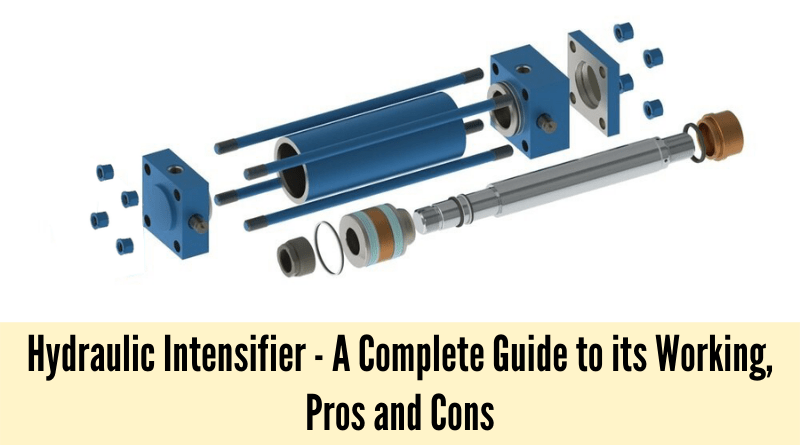
Hydraulic Intensifier – A Complete Guide to its Working, Pros and Cons
New to the world of hydraulics? Let’s dive into details of hydraulic intensifier.
A device that is connected to a normal hydraulic machine for increasing the amount of pressure the machine can produce is called as a hydraulic intensifier. The mechanism is operated by two pistons generally of the same size but can vary too, for adding pressure on the internal fluid. The large volume of liquid’s energy at low pressure is used for the mechanism. There are some hydraulic machines that work only under high pressure which a pump can’t provide. Such machines include hydraulic ram, hydraulic press, hydraulic lift, etc. These machines operate under high pressure to get the needed amount of pressure. A hydraulic intensifier is usually placed within the operating machine and the pump. There are two types of hydraulic intensifiers – single acting and double acting.
Hydraulic Intensifier in Details
A hydraulic intensifier is made of three main parts attached in a correct sequence for increasing the input fluid’s pressure. These include sliding cylinder, fixed ram and fixed cylinder.
- FIXED CYLINDER:
This is hydraulic intensifier’s outer body. This is where the liquid with low pressure enters from the main supply. The ram or sliding cylinder slides within the fixed cylinder.
- SLIDING CYLINDER OR RAM:
It is the next and middle part of hydraulic intensifier i.e. it slides in between the fixed cylinder and fixed ram. The ram is the single moving part in it. The hydraulic force helps it to slide. Sliding cylinder comprises of high pressure liquid supplied via the fixed ram.
- FIXED RAM:
It is the smallest and interior part of the hydraulic intensifier. It is surrounded by the sliding cylinder. The liquid with high pressure is received via this fixed ram.
- VALVES:
Hydraulic intensifier also consists of four valves. To make it easy for us to understand let’s name them A, B, C and D. ‘A’ and ‘D’ allow the liquid with low pressure to flow from the supply into the device. The liquid enters from valve ‘D’ goes into the fixed cylinder and goes in through the valve ‘A’ and further into the sliding cylinder. Valve helps in exhaustion i.e. it allows the low pressure liquid to flow from the fixed cylinder to be discharged for exhaustion. The valve ‘B’ supplies high pressure liquid to the outlet of intensifier attached with hydraulic machines.
Working of a Hydraulic Intensifier
As we know that hydraulic intensifier is used for increasing the intensity of fluid pressure. The working of the hydraulic intensifier depends on the fluid movement in it. The liquid from low pressure enters in and goes out at high pressure to the outlet or machine.
At the start the sliding cylinder is at rest i.e. at the bottom most position. Then the liquid of low pressure enters the fixed cylinder via the valve ‘D’ and fill it properly. Then the valve C, B and D are closed. Only the valve ‘A’ opens allowing the low pressure liquid into the ram or sliding cylinder. Next the valve ‘C’ opens and allows the low pressure liquid to flow from the fixed cylinder to be discharged to exhaust. Once the low pressure is out from the fixed cylinder the sliding cylinder reaches moves upwards because of the supply from valve ‘A’. Once the sliding cylinder reaches the topmost position, it gets filled with low pressure liquid. Both ‘A’ and ‘C’ are closed when the sliding cylinder completely fills with low pressure liquid. The ‘B’ and ‘D’ valves now open and the liquid with low pressure flowing through valve ‘D’ enters into the fixed cylinder, pushing the sliding cylinder to move downwards.
High pressure liquid is produced in the fixed cylinder which is supplied to the required output or to some hydraulic machinery. Then the high pressure liquid comes out from the valve ‘B’ and the cycle repeats continuously and low pressure liquid comes out with high pressure.
Hydraulic Intensifier Applications
- A hydraulic intensifier is used where there is requirement of high-intensity pressure.
- It is used when the pump alone can’t offer a high intensity of pressure as per the requirement.
- You will find the use of hydraulic intensifiers commonly in hydraulic ram, hydraulic cranes, hydraulic press, and hydraulic lifts, etc. where a high intensity of pressure is needed for lifting the loads.
Pros of Hydraulic Intensifier
- The body of hydraulic intensifier is compact and can be easily operated and controlled.
- It can be attached directly with the hydraulic machines or devices, where ever needed..
- When considering its working, it is budget friendly due to its easy and economical operation. Simply speaking it works smoothly, is safe and cost-effective in operations.
- It saves a lot of energy as compared to other devices.
- Because it can operate speedily, it can be easily started and stopped as per the requirements.
- The working becomes easy with the pump; hence, it may be attached in between the pump and the hydraulic machinery.
- It offers constant force and pressure in complete working process.
Cons of Hydraulic Intensifier
- One of the most important disadvantages of a hydraulic intensifier is leakage of the fluid which is commonly observed in other hydraulic devices too.
- The hydraulic fluid used may be corrosive sometimes damaging the body of machinery.
- The leakage fluid may catch fire so the working should be done in right manner and any small leakage of the fluids should be avoided
- Its maintenance is expensive.
This is a complete guide to the hydraulic intensifier. Hope it will help you to understand the important of the hydraulic intensifier. If you have any queries related to it, please feel free to contact us.



